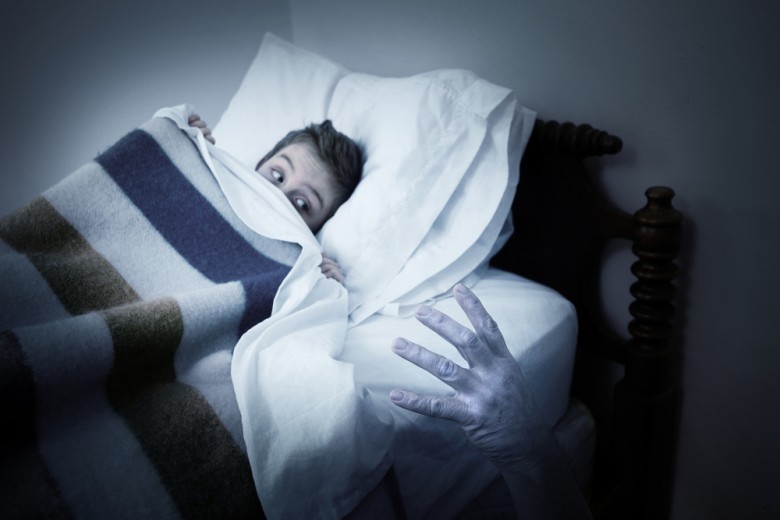Children's Nightmares

The occurrence of children's nightmares is a problem that comes up rather often in my work with parents. This is especially true for parents of children ages four to six. Usually the nightmares are similar and include monsters or other fantastic creatures that are threatening the child's demise. Sometimes they awaken the child in the middle of the night requiring the parents to comfort and reassure them.
Persistent nightmares often worry parents, but the truth of the matter is that these kinds of nightmares are quite normal for certain age groups, and are related to particular developmental tasks. Let me provide a quick summary.
Children begin having symbolic dreams around the age of two, but usually don't begin to report them with any regularity until around three. Even at this age they may not be able to distinguish very easily between the dream and reality, yet they can report some of the dream content. By five children will be able to realize that they have had a scary dream upon awakening from a nightmare, although they may still feel the effects of the dream for some time after they have awakened.
Nightmares Related to Developmental Tasks
Nightmares are frightening dreams that are usually reflective of children's emotional conflicts, particularly those related to developmental tasks. For example, toddlers who are working with the issue of separation may have dreams about losing their parents, not being able to see them, or not having physical access to them. Youngsters working on toilet training may have dreams that symbolically reflect parental disappointment, or a loss of approval and love. This might be particularly true if the youngster is having some difficulty with soiling and feels unsuccessful in his or her parents' eyes.
Between the ages of three and six, there is an upsurge in nightmares brought on by two particular aspects of emotional development. These are the awareness of aggressive drives and sexual impulses.
Aggressive Drives
Children do display aggressive behavior earlier than three years of age, but they aren't really very aware that the aggression is coming from within them until sometime after three. The increase in awareness goes hand in hand with the development of a self-concept that is crystallizing around the same time. As children become aware of themselves as separate selves with their own emotional life, they also become very acquainted with their negative emotions such as anger, jealousy, envy, wrath, and so forth. Nightmares serve a particular purpose in relation to aggressive drives. They allow the child to project into a dream the intensity of the emotions which are overwhelming to them, and then react to their own projection as though it was "out there" and could get them. The monster is nothing short of a representation of the child's aggressive impulses by which he is feeling overwhelmed and of which he is afraid.
Sexual Impulses
Sexual impulses play out a little differently. Around the ages of four or five, children become very aware of their gender differences. They realize they are either a boy or girl, and begin to make identifications with the same sex. Conversely, they may feel some attraction for the opposite sex, which at first shows up in their relationships with their parents. This is the stage where little boys talk about growing up and marrying mommy, buying her house, and setting daddy up in a house next door. Little girls tend to flirt with their daddies, dress up for them, primp in front of them, or maybe rough house more with them while mommy is excluded.
The nightmares related to this developmental stage are usually called oedipal nightmares and revolve around the alternating conflict of wanting to replace the parent of the same sex in the eyes of the other parent, and guilt about having such feelings. Or sometimes the dreams reflect the child's fear or recognition that the parent whom he desires to replace is bigger, stronger, and more powerful, and ultimately capable of winning the battle. Again, the powerful dream representation in the form of monsters and huge, hulking creatures serve the purpose of acting out the child's conflict.
What to Do?
What's important for parents to recognize is that most of these nightmares are quite normal, and will pass by the time children reach seven to eight years of age. In the meantime, the parent's job is to be as soothing as possible when they occur, and to make some allowances for dealing with the child's fear. Keep in mind that these dreams are truly frightening.
You can best calm your child's fear by allowing them to tell you about it, and then confirming for them that you are in control and can protect them. Remind them they have had a dream. You may have to spend some time in the middle of the night soothing them, and perhaps even stay with them for some time until they fall back asleep. Make use of night-lights, leave doors open, or maybe leave hall lights on. This is not a time to "tough it out."
QUICK TIPS: Avoid violent television, movies, stories, books, or any type of media that is scary. Also, children ages three to seven are particularly adversely affected by arguing or aggressive behavior by other family members, and you will most likely see an increase in nightmares if they are exposed to this type of stress. If nightmares persist after seven years of age, consider seeking professional counseling.
